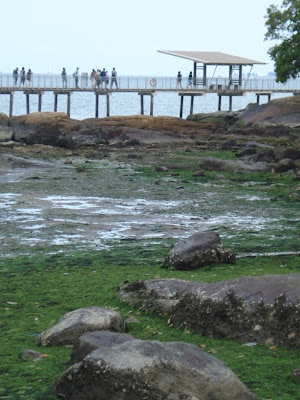At about 6am, I got a text from P., who was wondering whether the event will proceed given that it was raining heavily (it was towards the monsoon season - what can one expect?). As tempting as it was to sleep in on a rainy Saturday morning, there was something more exciting to get up for - a guided walk cum interfaith dialogue, conducted in-situ at Chek Jawa.
When we all got together at the Changi Point Ferry Terminal, the rain had long pettered out and we couldn't have asked for better weather. The clouds shielded us from the scorching sun, and we were treated to a balmy breeze to boot.

There were 10 of us, some of whom were friends of P, some were friends of mine and some from the EiF group of facilitators. The conversations flowed easily on the journey to Chek Jawa, and we started the session by formally introducing ourselves and the faith that we practice. Among us were Hindus, Baha'is, Muslims and Christians. And oh, a Baha'i role-playing a Taoist (thanks P.!) to add diversity to the group.

Everyone knows that breakfast is an important meal to start the day. So, before we set off on the guided walk, we were treated to a breakfast of bread and sardines that one of the participants bought. Food's always a fantastic way to break the ice!
I was supposed to do the guiding that day, but as it turns out, two of the participants, Pu. and M. were avid botanists and I learnt so much from them! This was a different experience of guiding for me. Usually on my walks, I do most of the talking but in this case, the participants are already comfortable with one another and I did more listening instead.
After the walk, we went back to House No. 1 and found that our spot had been hijacked by a rambunctious bunch of schoolchildren so we retreated to the area in front of the rescue tank. The TV was not on, so it was not too distracting though we did get odd stares from people walking by.
I brought my talking object with me, but decided not to use it because I really wanted to find out what it would happen if conversations were allowed to flow freely. What if you had a thought that you want to contribute before the conversation flows another direction? What if some participants would just prefer to listen and not want to feel threatened by having to speak when it comes to their turn? In the end, I suppose it comes down to the facilitator, and at the end of the exercise, I know which one works better for me.
I was really so fortunate to be able to meet with such a learned and expressive bunch of people, who shared their views openly and candidly. I couldn't have asked for a better bunch of people to share the day with. As it was my first time facilitating such a discussion, it was challenging to keep up with the range of views and the very quick twists in the conversations. Sometimes I felt the points raised were outside the topic we set out to explore, but it was difficult to interject when some participants clearly want to say something, and conversations were so animated. It was also difficult to truly listen deeply when replies come fast and furious. Free-flow conversations would probably work better for a brainstorm-type discussion rather than a dialogue-type setting.
In truth, we discussed about a wide range of topics, but for some reason, I came away thinking that religion holds valuable lessons in how to live one with nature, but until we learn that we really need to mend our ways, it seems our shabby treatment of our own living space is set to continue. Human beings seem to only respond when it is something urgent, not something slow like climate change. The participants are already environmentally-conscious, but do they represent the majority? I don't know. Can religion be the answer? Maybe. Would it morph into yet another tool of control in a new domain such as the environment? I don't know.
After the dialogue ended, the tide was at its lowest and we went back to see the orange fiddler crabs waving their oversized packages (their larger than life pincers) and even caught a heron on the dying tree. We then headed back towards the van where those in front caught sight of a family of wild boars.


It took me more than an hour to get home, and as soon as I stepped in, the heavens poured again. Almost as if the rains were held at bay just so we would all have a perfect Saturday afternoon. With great company, lovely environment, food for thought (and the tummy) - it really doesn't get any better than this.




